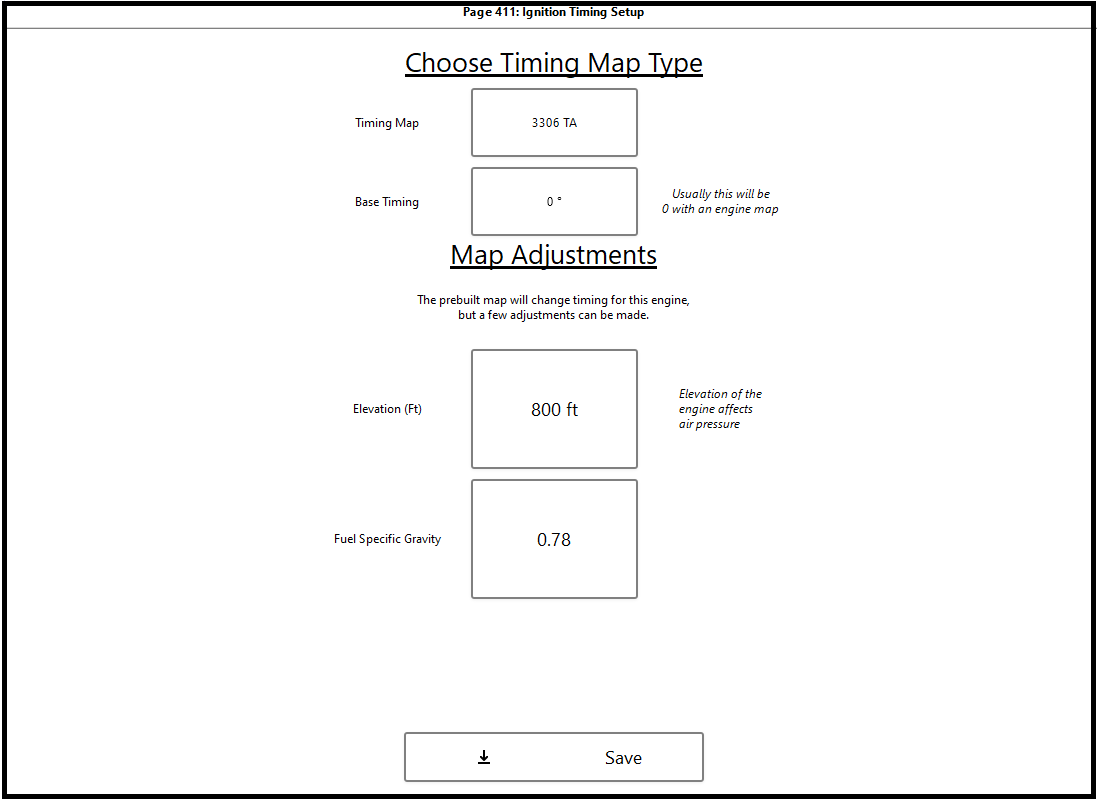Ignition Timing Adjustment
Overview
The active ignition timing is a sum of "Base Timing", which is a fixed manual timing adjustment, and either a prebuilt or custom timing map.
- For a prebuilt timing map, which is made for a specific engine, the ignition will adjust timing based on changes to speed and load (if a manifold pressure sensor is present). The map is also adjusted based on user-entered elevation and fuel specific gravity, if known. The Base Timing offsets the timing map some amount if desired.
- For a custom timing map, the user specifies an RPM Advance, which adjusts timing based on changes to RPM, and a Load Advance, which adjusts timing based on changes to load. The Base Timing is also used to quickly adjust the timing up or down. A custom map can also be used for fixed timing by setting the RPM advance values to the same advance.
The total timing is limited to the range 5 to 60 degrees BTDC, and if out of range it will be clipped.
Timing settings are changed under Ignition Setup -> Timing Setup
Base Timing
Base Timing is a manual timing adjustment that is fixed. The purpose of Base Timing is to allow the operator to quickly advance or retard the timing in small increments without having to modify the RPM Advance, Load Advance, or map settings.
Base Timing can be positive (timing advance) or negative (timing retard). Base Timing adjustments increment in 0.25° steps. Base timing is adjusted at the top of the timing setup screen.
If a prebuilt timing map is selected in ignition setup, the base timing will start at 0 degrees. The base timing can still be adjusted to raise or lower the timing. If in a prebuilt timing mode, it is not recommended to have base timing outside the range +/- 5 degrees.
Selecting a Timing Map
At the top of the timing setup page a timing map can be selected for a specific engine. Alternately, "Custom" can be selected to make a custom map.
Custom Map
If not using a built-in timing map, RPM Advance is used to automatically adjust ignition timing for changes to engine speed. Security access of Setup or Engineering is required.
For the low RPM timing:
- Set the low RPM value to the cranking RPM or at the lower range of operating RPM, whichever is desired
- Set the timing the ignition should be running at that specific RPM
For the high RPM timing
- Set the high RPM value to the maximum operational RPM
- Set the timing the ignition should be running at that specific RPM
The timing will automatically be interpolated between the two specified RPM values. If the engine speed runs below or above the RPM values, the timing will clip to those respective values.
Load Advance
If not using a built-in timing map, Load Advance is used to automatically compensate ignition timing for changes in engine load. In order to configure and utilize the Load Advance feature, a manifold pressure sensor (EMIT #13207) is required. The manifold pressure sensor can be directly wired to the ICM or wired to an AFRC or Governor, if equipped.
For the load advance low load timing:
- Enter the manifold pressure value that represents low or moderate load on the engine
- Enter the degrees of additional timing advance or timing retard at this load point
- This is typically left at “0.00°”
- Enter the percent load of the engine at this manifold pressure
For the high load timing:
- Enter the manifold pressure value that represents high load on the engine
- Enter the degrees of additional timing advance or timing retard at this load point
- Enter the percent load of the engine at this manifold pressure
When setting up Load Advance, keep in mind that the timing values are in addition to existing RPM Advance and Base Timing settings. For example, timing may already configured, but Load Advance is required to adjust timing for load swings. A typical Load Advance setup may have 0.0° at low load and -5.0° timing retard at high load.
Built-in Map Adjustments
If using a standard engine built-in map, there will be two additional adjustments shown on the timing setup page to help the map for a specific application.
- Elvation (ft): Enter elevation of the engine
- Fuel specific gravity: Enter specific gravity from gas report. The default is 0.78
